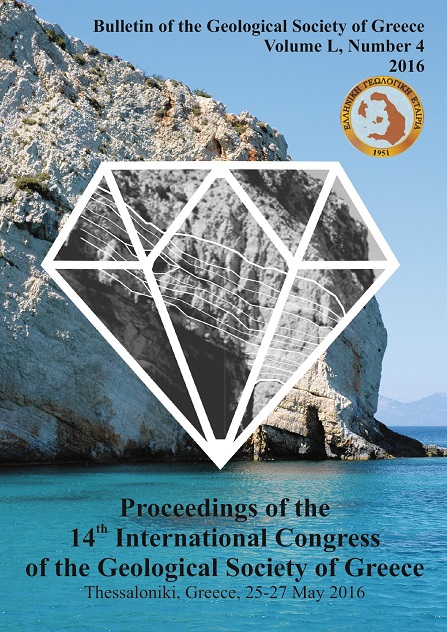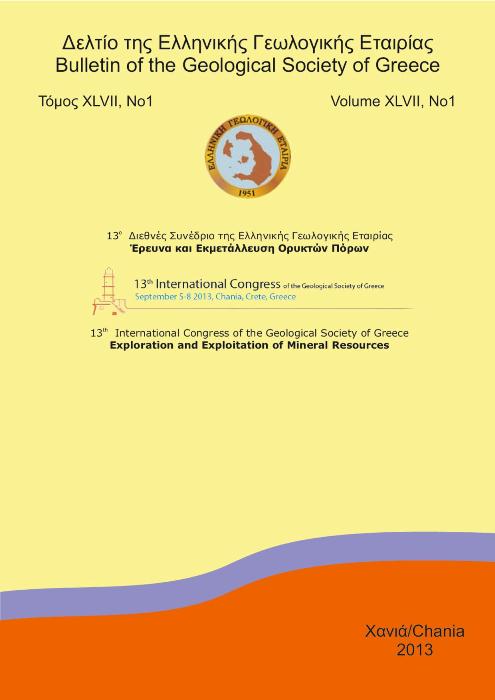GEOCHEMISTRY OF THE GAS MANIFESTATIONS OF GREECE: METHANE AND LIGHT HYDROCARBONS

Περίληψη
προελεύσεις ή/και δευτερογενείς μεταγενετικές διεργασίες. Δείγματα εκφορτισμένων αερίων που συλλέχθηκαν στις ακτές του Ιονίου Πελάγους και στο Βόρειο Αιγαίο, δείχνουν να επικρατεί η μικροβιακή προέλευση ενώ στις ψυχρές και θερμές εκπομπές αερίων της κεντρικής και βόρειας Ελλάδας η θερμογενετική. Το μεθάνιο που απελευθερώνεται από τα αέρια του ηφαιστειακού τόξου είναι κυρίως αβιογενές, αν και οι θερμογενετικές συνθήκες δεν μπορούν να εξαιρεθούν. Τα συλλεγμένα αέρια των περιοχών της κεντρικής Ελλάδας (λεκάνη Σπερχειού και βόρεια Εύβοια) πιθανά επηρεάστηκαν από έντονες δευτερογενετικές οξειδωτικές διεργασίες, όπως φαίνεται από τις υψηλές θετικές ισοτοπικές τιμές των C και H (έως +16.9‰ και +264‰ αντίστοιχα) και από τις χαμηλές αναλογίες των C1/(C2+C3).
Λεπτομέρειες άρθρου
- Πώς να δημιουργήσετε Αναφορές
-
Daskalopoulou, K., D’Alessandro, W., Cabassi, J., Calabrese, S., Fiebig, J., Grassa, F., Kyriakopoulos, K., Parello, F., & Tassi, F. (2016). GEOCHEMISTRY OF THE GAS MANIFESTATIONS OF GREECE: METHANE AND LIGHT HYDROCARBONS. Δελτίο της Ελληνικής Γεωλογικής Εταιρείας, 50(4), 1799–1807. https://doi.org/10.12681/bgsg.11919
- Ενότητα
- Πετρολογία και Ορυκτολογία

Αυτή η εργασία είναι αδειοδοτημένη υπό το CC Αναφορά Δημιουργού – Μη Εμπορική Χρήση 4.0.
Οι συγγραφείς θα πρέπει να είναι σύμφωνοι με τα παρακάτω: Οι συγγραφείς των άρθρων που δημοσιεύονται στο περιοδικό διατηρούν τα δικαιώματα πνευματικής ιδιοκτησίας επί των άρθρων τους, δίνοντας στο περιοδικό το δικαίωμα της πρώτης δημοσίευσης. Άρθρα που δημοσιεύονται στο περιοδικό διατίθενται με άδεια Creative Commons 4.0 Non Commercial και σύμφωνα με την οποία μπορούν να χρησιμοποιούνται ελεύθερα, με αναφορά στο/στη συγγραφέα και στην πρώτη δημοσίευση για μη κερδοσκοπικούς σκοπούς. Οι συγγραφείς μπορούν να: Μοιραστούν — αντιγράψουν και αναδιανέμουν το υλικό με κάθε μέσο και τρόπο, Προσαρμόσουν — αναμείξουν, τροποποιήσουν και δημιουργήσουν πάνω στο υλικό.






